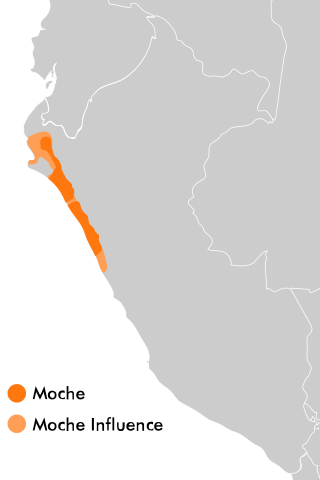
The Moche civilization flourished in northern Peru with its capital near present-day Moche, Trujillo, Peru from about 100 to 700 AD during the Regional Development Epoch. While this issue is the subject of some debate, many scholars contend that the Moche were not politically organized as a monolithic empire or state. Rather, they were likely a group of autonomous polities that shared a common culture, as seen in the rich iconography and monumental architecture that survives today.

La Libertad is a region in northwestern Peru. Formerly it was known as the Department of La Libertad. It is bordered by the Lambayeque, Cajamarca and Amazonas regions on the north, the San Martín Region on the east, the Ancash and Huánuco regions on the south and the Pacific Ocean on the west. Its capital is Trujillo, which is the nation's third biggest city. The region's main port is Salaverry, one of Peru's largest ports. The name of the region is Spanish for "freedom" or "liberty"; it was named in honor of the Intendencia of Trujillo's proclaiming independence from Spain in 1820 and fighting for that. It is the ninth smallest department in Peru, but it is also its second-most populous department after Piura and its second-most densely populated department after Lambayeque.
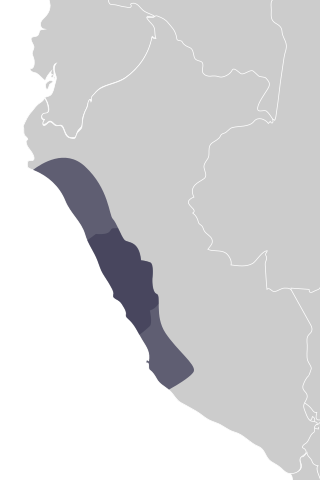
The Chavín culture is an extinct, pre-Columbian civilization, developed in the northern Andean highlands of Peru around 1000 BCE. It extended its influence to other civilizations along the Peruvian coast. The Chavín people were located in the Mosna Valley where the Mosna and Huachecsa rivers merge. This area is 3,150 metres (10,330 ft) above sea level and encompasses the quechua, suni, and puna life zones. In the periodization of pre-Columbian Peru, the Chavín is the main culture of the Early Horizon period in highland Peru, characterized by the intensification of the religious cult, the appearance of ceramics closely related to the ceremonial centers, the improvement of agricultural techniques and the development of metallurgy and textiles.

Chimor was the political grouping of the Chimú culture. The culture arose about 900 CE, succeeding the Moche culture, and was later conquered by the Inca emperor Topa Inca Yupanqui around 1470, fifty years before the arrival of the Spanish in the region. Chimor was the largest kingdom in the Late Intermediate Period, encompassing 1,000 kilometres (620 mi) of coastline.
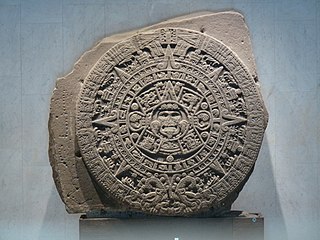
Pre-Columbian art refers to the visual arts of indigenous peoples of the Caribbean, North, Central, and South Americas from at least 13,000 BCE to the European conquests starting in the late 15th and early 16th centuries. The Pre-Columbian era continued for a time after these in many places, or had a transitional phase afterwards. Many types of perishable artifacts that were no doubt once very common, such as woven textiles, typically have not been preserved, but Precolumbian monumental sculpture, metalwork in gold, pottery, and painting on ceramics, walls, and rocks have survived more frequently.

The Raimondi Stele is a sacred object and significant piece of art of the Chavín culture of the central Andes in present-day Peru. The Chavín were named after Chavín de Huantar, the main structure found in ruin at this archaeological site. The Chavín are believed to have occupied this space from 1500 BCE to 300 BCE, which places them in the Early Horizon period of Andean cultures. The Early Horizon came to rise after the spread and domination of Chavín art styles, namely the hanging pendant eye and anthropomorphism/zoomorphism of feline, serpent, and crocodilian creatures. The stele is seven feet high, made of highly polished granite, with a lightly incised design featuring these key artistic choices shown in the depiction of the Staff God. After not being found in situ, the stele now is housed in the courtyard of the Museo Nacional de Arqueología Antropología e Historia del Perú in Lima.

Huaca de la Luna is a large adobe brick structure built mainly by the Moche people of northern Peru. Along with the Huaca del Sol, the Huaca de la Luna is part of Huacas de Moche, which is the remains of an ancient Moche capital city called Cerro Blanco, by the volcanic peak of the same name.
Peruvian territory was inhabited 14,000 years ago by hunters and gatherers. Subsequent developments include the appearance of sedentary communities that developed agriculture and irrigation, and the emergence of complex socio-political hierarchies that created sophisticated civilizations, technology and monumental construction.
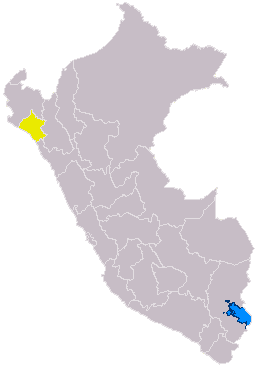
The Sican culture is the name that archaeologist Izumi Shimada gave to the culture that inhabited what is now the north coast of Peru between about 750 and 1375. According to Shimada, Sican means "temple of the Moon". The Sican culture is also referred to as Lambayeque culture, after the name of the region in Peru. It succeeded the Moche culture. There is still controversy among archeologists and anthropologists over whether the two are separate cultures. The Sican culture is divided into three major periods based on cultural changes as evidenced in archeological artifacts.

Located in the Chicama Valley, the El Brujo Archaeological Complex, just north of Trujillo, La Libertad Province, Peru, is an ancient archaeological site that was occupied from preceramic times. Considering the broad cultural sequencing, the Chicama Valley can be considered as an archaeological microcosm. The research benefits from the favourable environmental and topological conditions for material conservation.

The Brüning Museum, also known as Museo Regional Arqueológico Enrique Bruning de Lambayeque was inaugurated in 1966 and it is located in two blocks of the principal park in Lambayeque, Peru. It was based on the collections of Hans Heinrich Brüning, a German researcher.

Rafael Larco Hoyle, raised at Chiclin, his family's estate, was sent to school in Maryland, United States, at the age of twelve. He later entered Cornell University to study agricultural engineering and by 1923 returned to Peru to work on the family's sugar cane plantation. After spending most of his youth abroad, Larco Hoyle arrived to Peru with the eyes of an outsider. With this foreigner's curiosity he explored the country and discovered an ancient cultural patrimony in the north coast. Larco Hoyle recognized the need to house these objects in a safe place. It was at that point, Larco Hoyle dreamt of a museum, one like he had seen in the United States.

Ventarrón is the site of a 4,500-year-old temple with painted murals, which was excavated in Peru in 2007 near Chiclayo, in the Lambayeque region on the northern coast. The site was inhabited by the Early Cupisnique, Cupisnique, Chavin and Moche cultures.

Painting in the Americas before European colonization is the Precolumbian painting traditions of the Americas. Painting was a relatively widespread, popular and diverse means of communication and expression for both religious and utilitarian purpose throughout the regions of the Western Hemisphere. During the period before and after European exploration and settlement of the Americas; including North America, Central America, South America and the islands of the Caribbean, the Bahamas, the West Indies, the Antilles, the Lesser Antilles and other island groups, indigenous native cultures produced a wide variety of visual arts, including painting on textiles, hides, rock and cave surfaces, bodies especially faces, ceramics, architectural features including interior murals, wood panels, and other available surfaces. Many of the perishable surfaces, such as woven textiles, typically have not been preserved, but Precolumbian painting on ceramics, walls, and rocks have survived more frequently.

A stirrup spout vessel is a type of ceramic vessel common among several Pre-Columbian cultures of South America beginning in the early 2nd millennium BCE.

Kotosh is an archaeological site near the town of Huánuco, Peru, consisting of a series of buildings comprising six periods of continuous occupation.
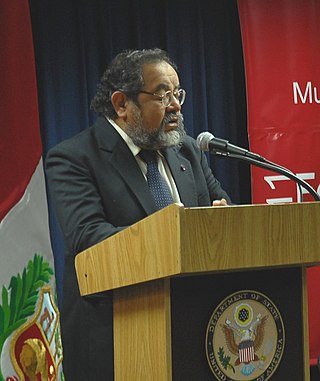
Walter Alva, full name is Walter Alva Alva, is a Peruvian archaeologist, specializing in the study and excavation of the prehistoric Moche culture. Alva is noted for two major finds: the tomb of the Lord of Sipan and related people in 1987, and 2007.
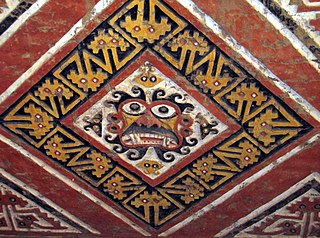
Ai apaec, was the chief deity of the Mochica culture. The most feared and adored of all punitive gods, it was also referred to as the “headsman”. Ai Apaec was worshipped as the creator god, protector of the Moche, a provider of water, food and military triumphs. Aiapaec means 'maker' in the Mochica language.

Pampa Grande is an archaeological site located in the Lambayeque Valley, in northern Peru, situated on the south shore of the Chancay River. It is located to the east of the city of Chiclayo.
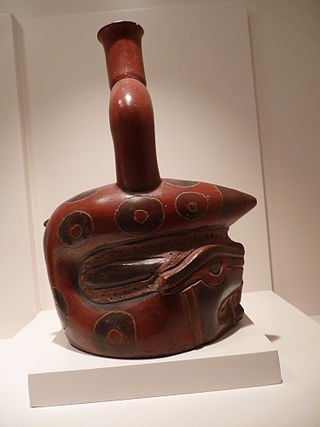
Caballo Muerto is an archaeological complex located on the northern coast of Peru, in the Moche Valley, in the Laredo District of La Libertad Region. It represents a series of mound sites that span both the Initial Period and the Early Horizon.






















